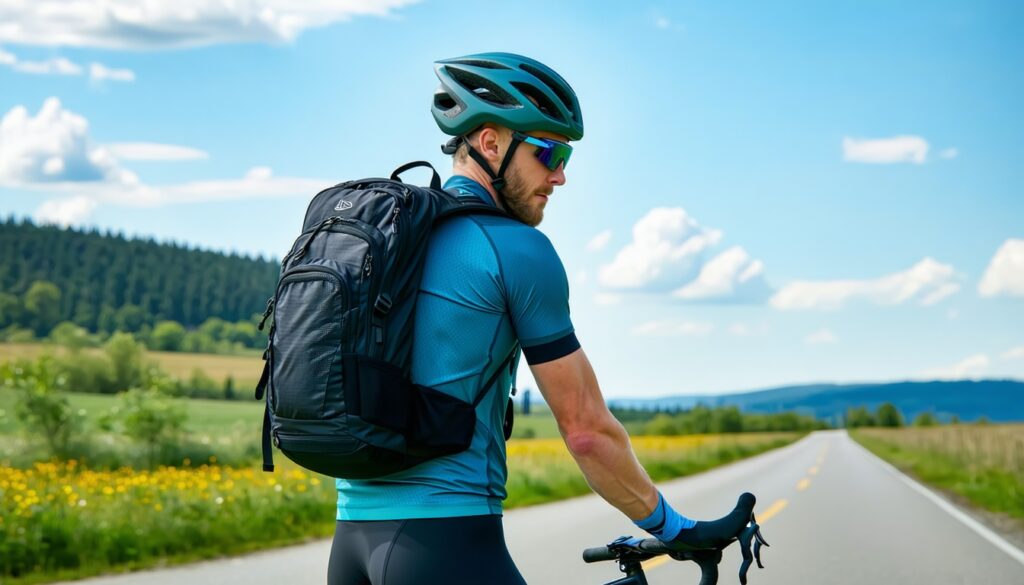How to Prevent Back Sweat While Using a Cycling Backpack

Understanding Back Sweat
Causes of Back Sweat
Back sweat is a common issue for many cyclists, arising from a combination of factors. Key among these is the sweat that builds up between the backpack and the cyclist’s back, which occurs due to a lack of airflow in the area. When a backpack fits too snugly against the back, especially during warmer weather, it can trap heat and moisture, leading to uncomfortable sweating. As cyclists pedal, the pressure from the backpack can exacerbate this situation, creating a perfect environment for back sweat.
Here is a quick overview of the primary causes of back sweat:
| Cause of Back Sweat | Description |
|---|---|
| Lack of Airflow | The space between the backpack and the back is insufficient for air to circulate. |
| Pressure from Backpack | The weight and fit of the backpack can trap heat and moisture. |
Impact of Back Sweat on Cyclists
For cyclists, especially commuters traveling daily to work, the impact of back sweat can be significant. The accumulation of sweat during a ride can lead to discomfort and even embarrassment, particularly in the scorching heat of summer. Excessive sweating not only distracts the cyclist but can also lead to chafing and skin irritation over time. Additionally, the inability to regulate body temperature effectively can hinder performance during longer rides. While sweating is a natural response, cyclists need to consider its effects on their cycling experience.
To combat this issue, products like VentaPak have been developed to help maintain airflow and body temperature, which is crucial, especially during intense or lengthy rides. This technology can significantly improve comfort levels, allowing cyclists to focus on their performance rather than their discomfort. By understanding the causes and impacts of back sweat, cyclists can better prepare and select the right gear to enhance their riding experience.
Fabric Choices for Cycling Backpacks
Choosing the right fabric for cycling backpacks can significantly influence comfort and help in how to prevent back sweat while using a cycling backpack. This section explores two excellent fabric options: Merino wool and synthetic materials like Nylon/Lycra and polyester.
Merino Wool Benefits
Merino wool is gaining popularity among cyclists due to its impressive moisture-wicking properties. It absorbs sweat effectively and dries relatively quickly, helping to maintain a comfortable temperature. The natural fibers provide a slight cushioning effect between the backpack and the skin, maximizing comfort.
| Feature | Benefits |
|---|---|
| Moisture Absorption | Effectively absorbs sweat |
| Quick Drying | Dries relatively fast |
| Comfort Cushioning | Offers cushioning between skin and backpack |
Merino wool also offers natural breathability, helping to regulate body temperature, which can minimize sweating during cycling.
Nylon/Lycra and Polyester Options
Synthetic fabrics such as Nylon, Lycra, and polyester are ideal for cycling gear, especially when considering heat during rides. These fabrics help wick sweat and moisture away from the skin, promoting evaporation and keeping cyclists dry.
Key Characteristics
| Material | Benefits |
|---|---|
| Nylon | Durable, lightweight, and breathable |
| Lycra | Stretchy and moisture-wicking |
| Polyester | Fast-drying and resistant to wear |
These synthetic options are essential for creating a cycling outfit that helps reduce back sweat. They work in combination with cycling backpacks to maintain a cool and comfortable riding experience. In addition, wearing mesh undershirts can further enhance moisture management.
By selecting fabrics strategically, cyclists can minimize discomfort caused by back sweat, ensuring a more enjoyable cycling experience. For more information on choosing the right backpack for cycling, check out our article on how to choose an ergonomic cycling backpack for comfort and posture.
Adjusting Backpack Straps
Properly adjusting backpack straps can significantly reduce back sweat while cycling. By focusing on weight distribution and airflow, cyclists can enjoy a more comfortable ride.
Weight Distribution
To prevent back sweat, cyclists should ensure that the weight of the backpack is evenly distributed. This can be achieved by:
- Positioning the backpack as high as possible on the back
- Securing the waist strap correctly to keep the backpack stable
- Packing heavier items on top to facilitate airflow
Weight distribution is essential because a well-balanced backpack reduces the strain on the back and promotes better posture. When the backpack is positioned correctly, it alleviates pressure points, which not only enhances comfort but also minimizes sweating due to less friction against the back. Research from Craft Cadence suggests that these adjustments are crucial for cyclists facing warmer weather conditions.
| Backpack Adjustment | Benefits |
|---|---|
| Positioning high on the back | Enhances airflow, reduces sweat |
| Correct waist strap use | Stabilizes pack, minimizes movement |
| Packing heavier items on top | Creates an airflow channel |
Airflow Promotion
To ensure airflow while cycling, cyclists should focus on positioning. Proper placement of the backpack can promote air circulation, thus mitigating sweat buildup:
- Adjust straps to encourage airflow beneath or behind the bag
- Utilize backpacks with built-in air vents on padded shoulder straps
- Opt for designs featuring EVA foam pads that increase airflow
Cycling backpacks with features like built-in hip and sternum straps enhance comfort while maintaining the right fit. This helps in reducing moisture and sweat accumulation on the back, making the riding experience more enjoyable. Maintaining a distance between the backpack and the back allows for better cooling through natural airflow. Keeping these strategies in mind can help any age of cyclist minimize back sweat while using a cycling backpack effectively. For more tips on selecting the right backpack, check out our article on how to choose an ergonomic cycling backpack for comfort and posture.
Efficient Packing Techniques
To minimize back sweat while cycling with a backpack, efficient packing techniques are essential. Proper weight distribution and airflow management can significantly enhance comfort during rides.
Weight Distribution in Backpack
Placing heavier items at the top of the backpack is an effective strategy. This shifts the center of weight closer to the upper back, creating a channel for airflow to the mid and lower back area. Reducing sweat accumulation in these areas is critical for a more enjoyable cycling experience.
| Packing Position | Effect on Weight Distribution |
|---|---|
| Heavier items on top | Shifts weight to the upper back, enhancing airflow |
| Lighter items on the bottom | Stabilizes the backpack |
Additionally, it’s important to securely adjust the backpack’s straps. This ensures the bag sits as high as possible on the back, allowing for optimal airflow and reducing the likelihood of sweat build-up.
Channeling Airflow
For air to circulate freely, it’s crucial to channel airflow effectively. By strategically placing items in the backpack, cyclists can promote ventilation.
- Top-Heavy Packing: Keep the heaviest items at the top. This helps create a natural space between the backpack and the lower back.
- Utilize Back Panel Features: If the backpack has a ventilated back panel, ensure it is aligned with the body to maximize breathability. Understanding why a ventilated back panel matters in a cycling backpack can provide insights for selecting the right gear.
By following these packing techniques, cyclists can effectively manage weight distribution and airflow, leading to a more comfortable ride without excessive back sweat. For further optimization, consider checking out our guide on how to choose an ergonomic cycling backpack for comfort and posture.
Features of Cycling Backpacks
Cycling backpacks come equipped with various features designed to enhance comfort and minimize back sweat. Understanding these features can help any cyclist make informed choices to enjoy their rides.
Air Ventilation Design
Backpacks designed with effective air ventilation features help to prevent sweat build-up on the back. These designs include mesh vents, ribbed panels, and channels that allow air to flow freely between the backpack and the back. This airflow helps keep the cyclist cool, especially during warmer weather when sweating is more common.
The table below summarizes the key elements of effective ventilation designs:
| Feature | Benefit |
|---|---|
| Mesh vents | Promote air passage, reducing moisture |
| Ribbed back panels | Create space for airflow |
| Adjustable straps | Ensure proper positioning for airflow |
| Deep mesh padding | Maximizes comfort while allowing airflow |
Hip and Sternum Straps
Properly positioned hip and sternum straps are essential for comfort during cycling. These straps help distribute the weight of the backpack evenly across the body, reducing stress on the back. Built-in hip and sternum straps stabilize the load and minimize movement, which can contribute to reduced sweating.
Additional benefits of using these straps include:
- Enhanced balance while riding.
- Increased comfort over long distances.
- Less strain on the shoulders, leading to a more enjoyable ride.
To learn more about how these straps improve stability, check out our article on how sternum and waist straps improve stability on the bike.
Shoulder Straps with Air Vents
Shoulder straps with built-in air vents are another effective feature to consider in cycling backpacks. These ventilated straps incorporate padding and air pockets that help maintain airflow while reducing heat build-up. This design prevents a sweaty back and ensures that cyclists remain comfortable throughout their ride.
Key advantages of shoulder straps with air vents include:
- Improved breathability across the shoulder area.
- Greater comfort is achieved by preventing friction and irritation.
- Enhanced support for the back during extended rides.
Cyclists looking for optimal comfort should prioritize backpacks with these ventilation features. By ensuring proper airflow, these designs help achieve a cooler and more pleasant cycling experience, significantly contributing to learning how to prevent back sweat while using a cycling backpack.
Clothing Impact on Back Sweat
To effectively address the issue of back sweat while cycling, understanding the impact of clothing choices is essential. The right fabrics can support moisture management, allowing cyclists to enjoy their rides without discomfort.
Sweat-Wicking Fabrics
The selection of fabrics plays a significant role in preventing back sweat during cycling. Materials such as Nylon/Lycra, polyester, spandex, and merino wool are excellent choices because they wick away moisture from the skin. This moisture-wicking action promotes evaporation and helps keep the body dry. Wearing heavy clothing, especially if made from non-breathable materials, can lead to increased sweating as it retains heat close to the skin.
| Fabric Type | Moisture Management | Breathability |
|---|---|---|
| Nylon/Lycra | High | Good |
| Polyester | High | Moderate to Good |
| Spandex | Moderate | Good |
| Merino Wool | High | Excellent |
Choosing cycling clothing made from these materials can help cyclists manage their comfort levels. The fabric’s ability to reduce sweat accumulation directly contributes to less sweat build-up between the back and the backpack.
Role of Clothing in Moisture Management
Cyclists often experience sweating due to backpacks that sit tightly against the back. This close fit can restrict airflow, resulting in accumulated sweat, especially in warm weather. To combat this issue, mesh undershirts can further enhance moisture management.
Layering breathable clothing can improve airflow, allowing heat to escape. This strategy helps create a more comfortable cycling experience without the worry of a sweaty back. It’s important for cyclists to consider both the clothing they wear and how it works with their chosen backpack to mitigate the effects of back sweat while riding. For additional insight into equipment compatibility, check out our guide on how to choose an ergonomic cycling backpack for comfort and posture.
Innovative Solutions for Back Sweat
VentaPak Technology
VentaPak technology offers an innovative approach designed specifically to combat back sweat for cyclists. It introduces airflow between the rider’s back and the backpack, effectively eliminating discomfort associated with heat and moisture. This means that even on long rides, cyclists can maintain a cool, dry, and comfortable back.
The design of VentaPak ensures that there is consistent airflow, helping regulate body temperature and prevent overheating. This is especially beneficial during high-intensity cycling or long-distance rides, where maintaining comfort is key.
Benefits of VentaPak for Cyclists
The benefits of VentaPak technology extend beyond merely reducing back sweat.
| Benefit | Description |
|---|---|
| Constant Airflow | VentaPak maintains airflow to keep the back cool and dry. |
| Improved Weight Distribution | The technology helps evenly distribute the weight of the backpack, enhancing posture and reducing strain on the back and shoulders. |
| Enhanced Comfort | Cyclists experience less discomfort and improved endurance during long rides. |
| Versatility | VentaPak is suitable for various cycling activities, including commuting and mountain biking, making it a go-to solution for all types of cyclists. |
Through these advantages, VentaPak significantly enhances the overall cycling experience, allowing riders to focus on their performance without the distraction of back sweat. For more on choosing the right ergonomic options, check out our guide on how to choose an ergonomic cycling backpack for comfort and posture.
VentaPak Features
Constant Airflow Technology
VentaPak is a revolutionary feature designed for cycling backpacks, aiming to address the common issue of back sweat. This technology introduces airflow between the cyclist’s back and the backpack, effectively eliminating discomfort caused by heat and sweat. By keeping the back cool and dry, VentaPak ensures a comfortable ride even on the longest journeys.
The constant airflow is particularly beneficial during high-intensity rides or long distances, as it helps maintain body temperature and prevents overheating. Riders can enjoy enhanced comfort without the annoyance of a sweaty back, making their cycling experience much more enjoyable.
Weight Distribution Improvement
In addition to airflow, VentaPak also improves weight distribution across the cyclist’s back. This feature helps to evenly distribute the load of the backpack, which contributes to better posture while riding. Proper weight distribution reduces strain on the back and shoulders, allowing for a more comfortable riding position.
Cyclists can ride longer without feeling the negative effects of an improperly balanced load, ultimately improving their endurance and overall comfort. This makes VentaPak suitable for all types of biking, from commuting to mountain biking. With the added benefits of reducing sweat and enhancing airflow, cyclists can focus on enjoying their ride, rather than discomfort.
For more insights on how to optimize your cycling experience, check out our articles on how to choose an ergonomic cycling backpack for comfort and posture and hydration-compatible cycling backpacks: what to look for.


